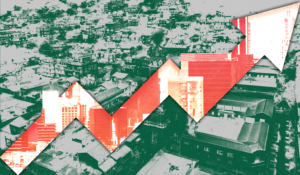Puerto Vallarta sits on a strip of coast in the Mexican state of Jalisco, at the foot of the Sierra Madre Occidental, a major mountain range that runs through the Western part of the country. The Night of the Iguana, and the drama surrounding its production, did play a part in Vallarta’s publicity back in the 60s. Puerto Vallarta has existed as a tourist destination for over seven decades – you only need to look at pictures to figure out why. However the film’s publicity and a combination of infrastructure development on behalf of the government kick started the city’s growth.
Today, Puerto Vallarta is described as the San Francisco of Mexico. The city is Mexico’s top destination for LGBTQIA+ tourism, especially for gay men. “We can say it’s LGBTQ+ tourism,” says Otoniel. “But if we’re being honest it’s more gay men than anyone else really.” Around a third of tourists in Puerto Vallarta are members of the LGBTQ+ community, and they have contributed a massive amount of money to the city’s finances – tourism makes up for about half of Vallarta’s economy.
But the city wasn’t originally built for the massive numbers of people that descend upon it each year, which has forced it to change to accommodate this huge source of revenue. The landscape of the city started to change as property developers moved to meet demand.
“There wasn’t any forced displacement, from what I understand,” says Otoniel, who wrote his PhD dissertation about LGBTQIA+ tourist destinations in Puerto Vallarta, and moved to Vallarta for four years in 2015. “But there was displacement in the sense that [property developers] offered locals a lot of money for their lots. So these little houses then turned into high rise buildings.”
“They’re not skyscrapers like in Mexico City,” Otoniel adds. “But in 2015 I noticed the amount of construction. And in Puerto Vallarta where the average house has two floors, you notice these concrete mammoths. Construction has slowed now, but only because they’re running out of space.”
Becoming a “gay paradise”
A lot of work has gone into the cityscape, but queer activists have worked just as hard to turn Vallarta into an environment that is safe for queer people. Puerto Vallarta is recognised as one of the safest destinations from the LGBTQIA+ community in the world.
Groups, including Vallarta’s LGBT Collective, have worked tirelessly to make sure discrimination against queer people doesn’t happen, delivering workshops to police as well as hospitality staff to educate them on inequality.
“It was hard because some [police] had certain… archaic concepts about LGBTQ+ people,” says Hector Ramirez Betancourt, founder of Vallarta’s LGBT Collective. “But we created the guidebook of rules to prevent and eliminate any type of discrimination in Puerto Vallarta. And now Vallarta is the number one tourist destination for gay people.”
Hector, known as Teto, was at the forefront of the creation of this rule book, which effectively criminalises discrimination against queer people. It is through tireless activist work, that continues today on behalf of Teto and other Mexican nonprofits, that Vallarta has become safe for all. Just last year MOVii, the Movement for Equality in Mexico, was hosting training sessions for police with the aim of teaching the importance of respecting people’s rights, no matter their gender or sexual orientation to continue making Vallarta an inclusive city.
“We’re at the vanguard of this,” says Teto. “We are closer to being at the level of some of the more inclusive countries. We did it because we,” the local LGBT population of Vallarta, “wanted to live well. And it’s also helpful, because it makes us number one,” says Teto.
That said, “Vallarta has always been a friendly city,” he says. And Teto isn’t the only one to say this – it seems to genuinely be a consensus among everyone I speak to. “The slogan was that it was the friendliest city in the world,” Teto adds.
“Vallarta will always welcome you,” says Adrian Mena Rubin de Celis, who has been living in Puerto Vallarta for 13 years. Adrian, originally for Mexico City, was supposed to live there for a year, but found it impossible to leave. “This is such a friendly city, it’s so humble. It doesn’t matter who you are or where you’re from or what you have, at some point it’s like we all know each other, support each other, and help each other,” says Adrian.
“For me, this is paradise,” Teto says. “I live in paradise… somewhere where there is no issues with discrimination, where we can live freely and in our way without having to hide, or worry about it being late or being dark. No matter the time of day here, there’s never an issue.”
The problem with development
Changes to the city skyline brought with them an increase to living costs, and ultimately a pricing out of many locals who relocated to the outskirts of the city. Rent and food costs went up, and as more people moved into the city infrastructure began to fail. The city has embarked on a project to fortify its sewers, but at one point water was running low and pipes couldn’t handle the amount of tourists using the infrastructure.
“When I lived there in 2015, garbage collection was also a problem,” adds Otoniel.
A significant chunk of Vallarta’s tourism is concentrated in the neighbourhood of Zona Romantica, which translates to Romantic Zone, in the centre of Vallarta. The neighbourhood is crowded with LGBTQIA+ bars, clubs, and hotels. But venues are slowly spreading onto the surrounding neighbourhoods of Conchas Chinas and the centre of Puerto Vallarta.
“There’s also the fact that a lot of people, such as digital nomads, they don’t pay taxes here,” says Otoniel. “They can have a house here but they won’t necessarily pay taxes, aside from [VAT]. This means that it’s harder to generate new infrastructure, and that complicates things because without new infrastructure, a city will collapse.”
